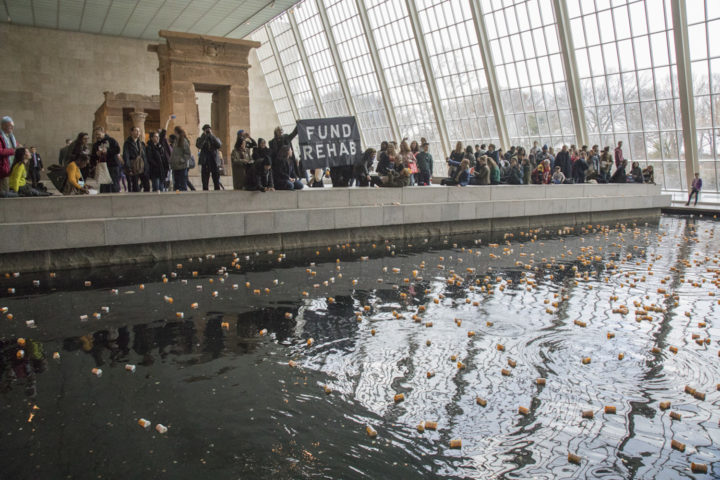Artists, activists, and addicts congregated just after 4 p.m. on Saturday inside Gallery 131 of the Metropolitan Museum of Art’s Sackler Wing, directly in front of the Temple of Dendur, for a public “die-in” during which roughly seventy participants lay on the floor as mock casualties of the unrelenting opioid epidemic in the United States that currently claims close to 150 lives per day.
The Egyptian temple erected under Roman rule around 15 B.C. — which would enter the U.S. as a gift from Egypt in 1965 — was awarded to the Metropolitan Museum of Art in 1967, and eventually installed in the Sackler Wing in 1978. P.A.I.N. (Prescription Addiction Intervention Now) demonstrators targeted the temple as their protest site because of its high profile in the art world (many fundraisers and dinners are held here), positioning it as a prime example of the Sackler family’s sterilized reputation as art patrons rather than owners of the pharmaceutical company Purdue Pharma, which is responsible for introducing OxyContin to the market in 1995 and recklessly downplaying its abuse potential by way of misleading marketing strategies.
Two black banners stenciled with white lettering were embedded within the crowd and legible throughout the demonstration, one reading “SHAME ON SACKLER” and another insisting that the Sacklers “FUND REHAB” as part of a suite of reparations owed to the American public.

“I went from the darkness and ran full speed into The World,” begins Nan Goldin’s confessional call-to-arms based on her own three-year experience with opiate addiction, which started in 2014 and spanned 2017. “I was isolated, but I realized I wasn’t alone.” Goldin’s essay is one of seven contributions to a January 2018 Artforum feature titled “The Uses of Power.” Using this theme as a prompt, artists and writers were asked to “picture our current life and imagine possible lives otherwise,” as well as to “consider how we can and should use power.”
Goldin’s text is accompanied by a portfolio of eleven images, some of which shed light on her darkened interior life as an addict — self-portraits and captured tableaus of her drug and its related paraphernalia that would often populate the artist’s floors, desks, and countertops. Other images, cropped and arranged by Goldin in grid formations, show a selection of institutional plaques of philanthropic honor that can be seen above doorways and on the walls of many of the world’s most highly regarded art and academic institutions. Polished surfaces bear engraved homages and respectful recognition of one or more facets of the Sackler family’s multipronged empire.
The solution-driven bottom line of Goldin’s response: “I’ve started a group, P.A.I.N. (Prescription Addiction Intervention Now), to hold them accountable. To get their ear we will target their philanthropy. They have washed their blood money through the halls of museums and universities around the world. We demand that the Sacklers and Purdue Pharma use their fortune to fund addiction treatment and education. There is no time to waste.”

A Change.org petition — launched alongside Goldin’s Artforum statement released in January — is one among a few budding courses of action through which Goldin plans to apply an increasing amount of collective pressure to hold the Sacklers accountable for the crisis. The petition, addressed to such entities as Purdue Pharma, The Sackler Family, The Mortimer D. Sackler Foundation Inc., and the Raymond & Beverly Sackler Foundation, has so far accumulated nearly 33,000 of its 35,000-signature goal.
One hundred pill bottles, “prescribed to you by the Sackler family, major donors of the Met,” were tossed like coins into the moat during the twenty-minute rally. Listed at the very bottom of each of the small floating canisters was a startling statistic: “RX# 200,000 dead.”
Noemi Bonazzi, a stylist, set designer, and close friend of Goldin’s, recalls the artist’s early resolve to start the P.A.I.N. group and carry out a series of direct actions after reading and discussing a number in-depth exposés of the Sackler Family’s connection to the opiate epidemic in publications including The New Yorker, Esquire, and The Guardian.
According to the American Society of Addiction Medicine, four out of five people who try heroin today started with prescription painkillers, and it was Goldin’s use of a near-deadly mixture of heroin and fentanyl — which she had sought out as a cheaper alternative to her waning supply of OxyContin — that led to an overdose and subsequent admission into a rehabilitation treatment center in January of 2017.

Saturday’s demonstration was a prime example of meaning being injected into objects and sites in concentrated bursts and in the name of resistance. Bonazzi spoke of the choreographed timing and planned visual effect of the water-logged pill bottles, which came to fill the temple’s surrounding moat — “the action of going into one’s pocket or bag” — as a powerful way to bring a very real problem out into the public sphere.
“Goldin’s addiction is also our epidemic, and the forces she holds responsible include a family, not as private as they used to be, that has profited directly from the unspeakable pain of others,” writes David Velasco in his Editor’s Letter in Artforum’s January 2018 issue.
Goldin’s familiarity with the art of turning the personal, or private, into the political will continue to be a force to be reckoned with as she and fellow organizers prepare for more awareness campaigning and direct action down the line.

